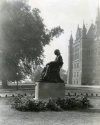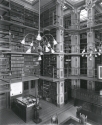Georgetown Football Team with Hoya I, 1927
CLAIM: The Georgetown Mascot has always been a Bulldog.
ANSWER: Not true!
The English Bulldog wasn’t officially adopted as the University mascot until 1962. Georgetown had been without a live mascot since 1951 when football was suspended on campus. By 1962, a group of students decided it was time to bring back the live mascot tradition and formed the Georgetown Mascot Committee to do just that. The Committee raised enough money to buy an English Bulldog, which they officially adopted as the mascot of Georgetown. “Jack” arrived on campus in the fall of 1962. The students wanted to name the new dog “Hoya” but he refused to answer to anything but “Jack.”
Before the arrival of Jack, mascot duties fell to a variety of dogs. Past mascots have included a former war dog named Stubby, a succession of Boston Bull Terriers named Hoya, and a Great Dane named Butch. Records also indicate that a small child once assumed mascot duties for a football game against Virginia in 1911./p>
John Carroll Statue, 1952
CLAIM: The Carroll Statue didn’t originally have books stacked underneath the chair and students would play pranks by putting a chamber pot beneath the chair.
ANSWER: Not true!
The John Carroll Statue you see today appears exactly as it was designed. Sculptor Jerome Connor based his design of Carroll on the statue of John Harvard at Harvard University, which also features books underneath his chair. So, the books under the chair have always there.
The John Carroll Statue you see today, though, is not the same statue that was unveiled on May 4, 1912. In 1940, Brother James Harrington, S.J. recounted a story to The Hoya about how, after thousands of invitations to the ceremony had been sent out, the foundry casting the statue notified the University that it would not be ready in time for the event. Rather than cancel the ceremony, University administrators had a plaster cast made of the statue and painted it bronze. This bogus bronze statue was unveiled to a large gathering of distinguished guests which including the Chief Justice of the Supreme Court and the Speaker of the House of Representatives. A few weeks later when the real statue arrived, workmen swapped the two statues out in the dead of night, hoping that no one would notice.
President-elect Bill Clinton speaking in front of Old North, 1993
CLAIM: 14 U.S. Presidents have spoken from the top step of Old North.
ANSWER: True!
Old North served as GU’s main building until Healy was completed and so it served as the place where important guests were received. The Presidents visited campus for a variety of reasons, including attending commencement ceremonies and to deliver important speeches. The 14 Presidents are George Washington, John Quincy Adams, Andrew Jackson, John Tyler, James K. Polk, Zachary Taylor, Franklin Pierce, James Buchanan, Abraham Lincoln, Ulysses S. Grant, Andrew Johnson, Gerald Ford, William J. Clinton, and Barack Obama.
Georgetown College Journal, June 1876. Account of the selection of school colors by the Boat Club.
CLAIM: The Union blue and Confederate gray were adopted as school colors after the Civil War ended to symbolize unity.
ANSWER: Sort of.
Georgetown’s colors came about because of Crew. When the Boat Club was formed in March 1876 one of its first actions was to appoint a Committee on Colors. Georgetown did not have colors and it was felt that they were needed so that supporters on shore could identify the crew team during races. An article in the Georgetown College Journal of June 1876 (the only account of the Committee’s work that has survived), explains how the Committee, looking for colors to express the feeling of unity that exists between the Northern and Southern boys of the College, recommended the adoption of blue and gray. A subsequent Journal article describes how young ladies from the neighboring Visitation Academy immediately sewed a half blue, half gray banner, with the inscription Ocior Euro (“Swifter than the Wind” in Latin), and presented it to the College.
College Yells, 1911
CLAIM: The "Hoya Saxa" traces its origin to early football games.
ANSWER: Probably but no one really knows for sure.
It has been suggested that origins of the word, Hoya, which formed part of the College yell or cheer, Hoya! Hoya! Saxa!, can be linked to the Stonewalls Baseball Club which date back to the 1860s. The theory is this: a student using a mixture of Greek and Latin (which were emphasized by the curriculum) dubbed the Stonewalls, Hoia Saxa. Hoia is the Greek neuter plural for what or what a, while saxa is the Latin neuter plural for large or rough rocks. Taken together, Hoya Saxa literally means "what rocks" – the suggestion being that the players were as hard as rocks. Others have speculated that Hoya Saxa referred not to the team but to its surroundings and the stone wall that ran along 37th Street. In 1992, however, Fr. William McFadden, S.J. wrote an article entitled “What the Hell is a Hoya?” disputing the Greek/Latin theory.
The cheer itself, though, is first acknowledged in print in the Georgetown College Journal in 1891 following a football victory and appears regularly as part of the college yells that were printed and distributed at football games. Our Baseball records do not include similar items so it is probably safe to say football gave birth to the “Hoya Saxa” as we know it today but its origins are lost to history.
Cannons in front of Healy Hall, ca. 1900
CLAIM: The cannons outside of Healy Hall were brought to America in the 17th century and they are the only pieces of artillery allowed to aim towards the White House (because they were placed there before the White House was built).
ANSWER: Only half true!
The cannons were a part of Lord Baltimore's expedition to St. Mary's County in 1634. They were not a part of the armament of the Ark and the Dove, but rather were to guard Fort Point and St Mary's City, the seat of the Provincial Assembly of Maryland. The cannons were placed on the banks of the St. Mary's River, but fell into the water as the river bank eroded over time. They became partly covered with mud and oyster shells and were corroded by the salt water. They were removed from the mud and water in 1824 and taken to St. Inigoes for restoration. It is said that about 1885 Father James A. Doonan, S.J., President of Georgetown College, bought the two cannons for $50. Arriving at the Hilltop on November 1, 1888, they were placed in their current location in front of Healy.
As the White House was completed November 1, 1800 and the cannons not set until 1888, the latter part of this claim cannot be true.
Jug-Rat Association “Annual Extermination” program, 1863
CLAIM: Students who were misbehaving were often sent to the top of the spires of New North.
ANSWER: True!
Until the 20th century, students who violated minor rules on campus were punished by having to memorize and publicly recite lines of Latin poetry, and more serious offenses were punished by confinement (on a diet of bread and water) to a room in one of the towers of Old North or by expulsion. When a culprit had lines to learn, he went to the "jug" or detention room and was considered by his fellow students to be a "jug rat." Punishment lines were cumulative, and it was possible for a student who was given to rule-breaking and not blessed with an aptitude for memorization to be in the "jug" for most, if not all, of a school year, although lines did not carry over from year to year. A Jug-Rat Association operated sporadically at Georgetown during the second half of the 19th century. Its main activity appears to have been an annual "extermination," held in June after the end of classes. A program of music and speeches, the "exterminations" were a parody of commencement ceremonies and generally attracted large external audiences.







